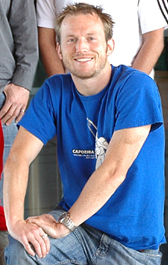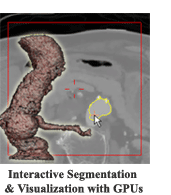|
Anthony Sherbondy [ Contact ] "Thinking is more interesting than knowing, but less interesting than looking." - J. W. von Goethe |
||
| Curriculum Vita | |||
Recently, I finished my Ph.D. thesis, "Measurement and visualization of white matter fascicles using magnetic resonance diffusion-weighted imaging fiber tractography", at Stanford University. I was extremely fortunate to have been advised by two great mentors at Stanford: Sandy Napel (Radiology) and Brian Wandell (Psychology). Other professors that I owe a great deal for their mentorship and many hours spent working with me at Stanford include Pat Hanrahan (Computer Science) and Art Owen (Statistics) My first research passion was the development of interactive scientific visualization and measurement tools that focused on enhancing experimental control and intuitive manipulation of data. A few years later, my second passion became using these tools to measure properties of the white matter in the brain. Neuroscience My research interests in the brain are focused on measuring properties of the brain's white matter using diffusion-weighted MRI. My exploration in this area began as a project to develop visualization software (DTI-Query) that facilitated interactive exploration of hypotheses about connectivity using fiber tractography. After this work, I introduced two of my own algorithms for fiber tractography: Connectivity Tracking (ConTrack) and Fascicle Tracking (FascTrack). Earlier Visualization Software Research As one of my first projects at Stanford, I combined various standard visualization techniques to understand their utility for enhancing radiologist performance when interacting with a proposed computer automated detection system for lung nodules within CT volumes. I was advised by Geoff Rubin and Sandy Napel during this work.
Anthony J. Sherbondy, Robert F. Dougherty, Michal Ben-Shachar, Sandy Napel, and Brian Wandell, “ConTrack: Finding the most likely pathways between brain regions using diffusion tractography.” Journal of Vision, 8(9):15, pp. 1-16, 2008. Anthony Sherbondy, David Akers, Rachel Mackenzie, Robert Dougherty, and Brian Wandell, "Exploring Connectivity of the Brain's White Matter with Dynamic Queries." IEEE Transactions on Visualization and Computer Graphics, Volume 11, Issue 4 (July 2005) pp. 419-430. Anthony J. Sherbondy, Djamila Holmlund, Geoffrey D. Rubin, Pamela K. Schraedley, Terry Winograd and Sandy Napel, “Alternative Input Devices for Efficient Navigation of Large CTA Studies,” Radiology 234(2):391-398, 2005. Geoffrey D. Rubin, John K. Lyo, David S. Paik, Anthony J. Sherbondy, Lawrence C. Chow, Ann N. Leung, Robert Mindelzun, Pamela K. Schraedley-Desmond, Steven E. Zinck, David P. Naidich and Sandy Napel, "Pulmonary Nodules in MDCT
Scans: Impact of Computer-aided Detection,” Radiology 234(1):274-273, 2005. Refereed Conference Proceedings
Sherbondy, A., Dougherty, R., & Wandell, B. “Identification of optic radiation in-vivo using diffusion tensor imaging and fiber tractography.” Vision Sciences Society 2008. Anthony J. Sherbondy, Robert F. Dougherty, Michal Ben-Shachar, Sing-Hang Cheung, Sandy Napel and Brian A. Wandell. “Identifying the most likely white matter pathways between two brain regions,” Society for Neuroscience 2007, San Diego. Anthony J. Sherbondy, Silvia S. Blemker, Edith M. Arnold, Sandy Napel, Scott L. Delp, Gary E. Gold. “Measuring human gastrocnemius pennation angle utlizing most likely pathway distributions in diffusion tensor imaging”. 15th Annual Meeting ISMRM, Berlin, Germany, 2007. Sherbondy AJ, Akers DL, Dougherty RF, Ben-Shachar M, Napel S, Wandell BA, “MetroTrac: A Metropolis Algorithm for Probabilistic Tractography”, poster, Human Brain Mapping, Florence, June 2006. Sherbondy AJ, Houston M, Napel S, "Interactively Guided Volumetric Segmentation Using Programmable Graphics Hardware," presented at the Radiological Society of North America 89th Scientific Sessions, November 2003. Rubin GD, Naidich DP, Sherbondy AJ, Lyo JP, Napel S, "Inadequacy of Lung Nodule Reference Standard Based Upon Standard Methods of Expert Consensus Review Using Cine-paging of Transverse Thin-section MDCT Lung Scans," presented at the Radiological Society of North America 89th Scientific Sessions, November 2003. Rubin GD, Lyo JP, Paik DS, Sherbondy AJ, Naidich DP, Napel S, "Impact of Computer-assisted Detection (CAD) Algorithm vs a Second Radiologist on Reader Sensitivity for Detecting Pulmonary Nodules in MDCT Scan," presented at theRadiological Society of North America 89th Scientific Sessions, November 2003. William E. Higgins, Atilla P. Kiraly, et al., “Use Of Integrated Virtual-Bronchoscopic Analysis During Live Bronchoscopy,” Radiology, vol. 221 (P), pg. 719, November 2001. W.E. Higgins, A.J. Sherbondy, et al., “Virtual Bronchoscopy for 3D CT Assessment and Endoscopic Guidance,” Radiology, vol. 217(P), page 706, Nov. 2000. ConTrack - Software for identifying the most likely pathways of white matter between regions in the brain using diffusion imaging fiber tractography DTIQuery - Software for exploring connectivity in human brain white matter using diffusion tensor imaging, tractography and dynamic query techniques VISTASOFT - Tools for vision and imaging science. I have made several contributions to this toolkit and most notably to the DTI analysis tools. Stanford University Radiology Framework (SURF) - Framework for rapid development of visualization applications for clinical study. Fiber Shape Analysis - Software for performing clustering and shape analysis on potential neural pathways retrieved from tractography on diffusion tensor imaging data. This software was a class project for a course I took in applied multivariate analysis taught by John Kettenring. I won the book "An R and S-Plus Companion to Multivariate Analysis" by Everitt for this project. Virtual Navigation Bronchoscopy Suite (VN) - Used for planning bronchoscopic procedures and guidance during bronchoscopy. Focused on a unique method for fusing acquired bronchoscopy video with previously acquired computed tomography images.
|
|||


